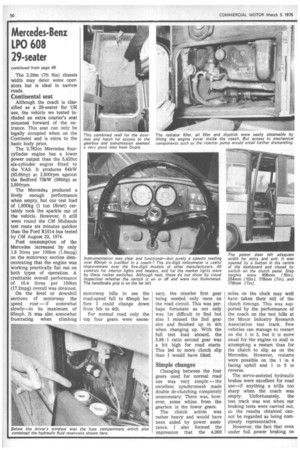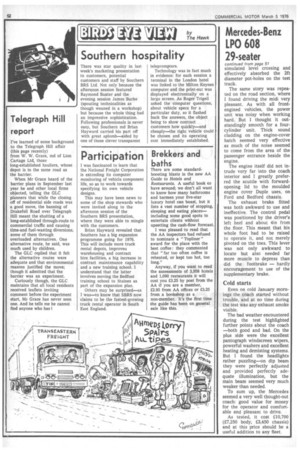Mercedes-Benz 110 608 Duple Dominant 29-seater
Page 51

Page 52

Page 53

Page 54

If you've noticed an error in this article please click here to report it so we can fix it.
by Martin Watkins
photographs by Harry Roberts BRITISH coach operators have a choice of only a small number of midi chassis, so the availability of the Mercedes I-608D is to be welcomed. Two of these chassis have now been bodied by Duple, and CM has just been able to test the first one—operated by Solent Coaches of Portsmouth and lent by Spartrucks of Andover.
This vehicle had covered 4,000 miles since delivery in September and could thus be regarded as being virtually in peak condition.
With larger-size coach chassis from different manufacturers becoming more and more similar it was a pleasure to get behind the wheel of a coach which felt very different from either the Bedford VAS or Bristol LHS—its main competitors.
First impressions of the Mercedes must be good for anyone who likes the "feel" of quality. The steering wheel is nearly horizontal and is fully 0.56m (if t 10in) in diameter. The gearlever is short, but with a very positive linkage. A push-button starter is fitted.
Augmenting the favourable first impression is the quality coachwork from Duple which makes the best of the rather squat looks of Mercedes chassis. After 400 miles of driving I was just as impressed with the coach apart from the sluggish performance when loaded. The 2.29m (7ft fin) chassis width may deter some operators but is ideal in narrow roads.
Continental seat
Although the coach is classified as a 29-seater for UK use, the vehicle we tested included an extra courier's seat mounted forward of the entrance. This seat can only be legally occupied when on the Continent and is extra to the basic body price.
The 3,782cc Mercedes fourcylinder engine has a lower power output than the 5,420cc six-cylinder engine fitted to the VAS. It produces 64kW (85.6bhp) at 2,800rpm against the Bedford 73kW (98bhp) at 2,600rpm.
The Mercedes produced a lively enough performance when empty, but our test load of 1,800kg (1 ton 16cwt) certainly took the sparkle out of the vehicle. However, it still went round the CM Midlands test route six minutes quicker than the Ford R1014 bus tested by CM August 22, 1974.
Fuel consumption of the Mercedes increased by only 1.8 litres per 100km (1.8mpg) on the motorway section demonstrating that the engine was working practically flat out on both types of operation. A creditable overall performance of 16.4 litres per 100km (17.2mpg) overall was obtained.
On the level or downhill sections of motorway the speed rose — if somewhat slowly—to its maximum of 65mph. It was also somewhat frustrating when climbing motorway hills to see the road-speed fall to 40mph before I could change down from 5th to 4th.
For normal road only the top four gears were neces sary, the crawler first gear being needed only once on the road circuit. This was perhaps fortunate as not only was 1st difficult to find but also I missed the 2nd gear slot and finished up in 4th when changing up. With the full test load aboard, the 3.88:1 ratio second gear was a bit high for road starts. This led to more clutch slip than I would have liked.
Simple changes
Changing between the four gears used for normal road use was very simple— the excellent synchromesh made double de-clutching completely unnecessary. There was, 'however, some whine from the gearbox in the lower gears.
The clutch action was rather heavy and would have been aided by power assistance. I also formed the impression that the 4,000 miles on the clock may well have taken their toll of the clutch timings. This was supported by the performance of the coach on the test hills at the Motor Industry Research Association test track. Few vehicles can manage to restart on the 1 in 3, but it is more usual for [the engine to stall in attempting a restart than for the clutch to slip as on the Mercedes. However, restarts were possible .on the 1 in 4 facing uphill and 1 in 5 in reverse.
The servo-assisted hydraulic brakes were excellent for road use—if anything a trifle too sharp when the coach was empty. Unfortunately, the test track was wet when our braking tests were carried out, so the results obtained cannot be regarded as being completely representative.
However, the fact that even under full power braking on the wet track no wheels locked up suggests that the dry stopping distance would not necessarily be a great deal less in ideal conditions.
The parking brake was of the pistol-grip type. This came out of the floor on the driver's left. To grab the handle, the driver had to lean very far forward-and he was alsiti in dan ger of skinning his wrist as he pulled the brake on. This was because the handle passed within about lft of the sharp edge of the dashboard. But the handbrake was certainly effective as it held the laden coach facing downhill on the 1 in 3 at MIRA and uphill on the 1 in 4. On the road I often found myself holding the coach on the footbrake to avoid using the handbrake.
Winding
The ride and handling of the little coach left little to be desired either on the test track or the open road. The large steering wheel and lowgeared steering made cornering effortless even if the six and three-quarter turns lock to lock did entail some winding.
On the negative cambers of the test track the rear of the coach tended to slide as the back offside suspension sank and the front nearside rose up. Otherwise the suspension coped well with all conditions. It never bottomed even on the simulated level crossing and effectively absorbed the 2ft diameter pot-holes on the test track.
The same story was repeated on the road section, where I found driving the midi very pleasant. As with all frontengined vehicles, the power unit was noisy when working hard. But I thought it outstandingly smooth for a fourcylinder unit. Thick sound cladding on the engine-cover hatch seemed very effective as much of the noise seemed to come from the area of the passenger entrance beside the engine.
The engine itself did not intrude very far into the coach interior and I greatly preferred the scuttle with forwardopening lid to the moulded engine cover Duple uses, on Ford and Bedford chassis.
The exhaust brake fitted was both awkward to use and ineffective. The control pedal was positioned by the driver's left heel and about 4in from the floor. This meant that his whole foot had to be raised to operate it, and not merely pivoted on the toes. This lever was not only awkward to locate but also needed far more muscle to depress than did the footbrake — hardly encouragement to use of the supplementary brake.
Cold starts
Even on cold January mornings the coach started without trouble, and at no time during the test was any exhaust smoke visible.
The bad weather encountered during the test highlighted further points about the coach —both good and bad. On the plus side were the excellent pantograph windscreen wipers, powerful washers and excellent heating and demisting systems. But I found the headlights rather puzzling—on dip beam they were perfectly adjusted and provided perfectly adequate illumination, but the main beam seemed very much weaker than needed.
To sum up, the Mercedes seemed a very well thought-out coach: good value for money for the operator and comfortable and pleasant to drive.
As tested, it cost £10,700 (E7,250 body, £3,450 chassis) and at this price should be a useful addition to any fleet.




















































































































































